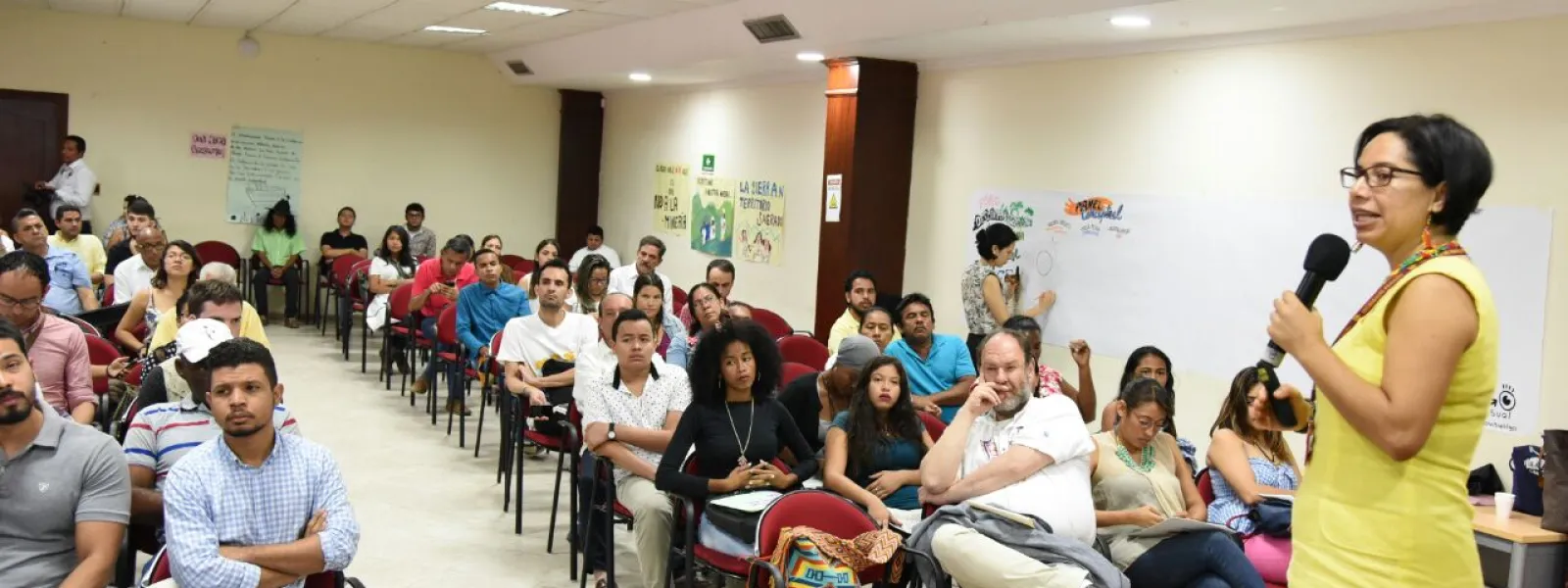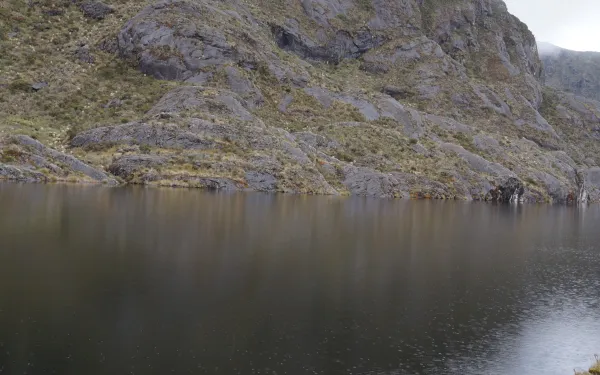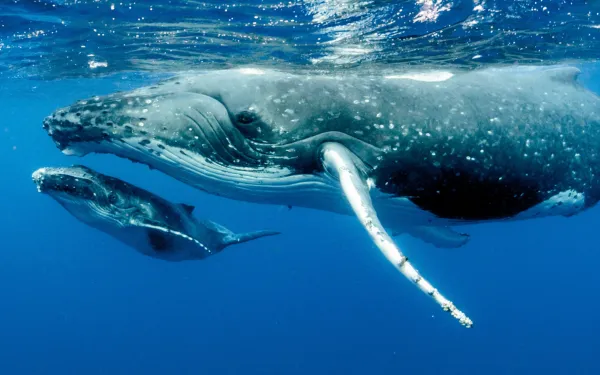
Project
Organizing the Network for Environmental Justice in Colombia
The Network for Environmental Justice in Colombia is an effort to coordinate organizations and legal resources for the protection of human rights and the environment.
The Network was founded in 2010 under the coordination of AIDA and with the help of the Latin American Institute for Alternative Society and Law, the Institute for the Study of Peace and Development, the Inter-Ecclesial Commission for Justice and Peace, and the University of Los Andes, the University of Caldas, and Del Rosario University. The network began with 79 participants and now includes more than 500 people and participating organizations.
The Network’s principal objective is to propose solutions to environmental conflicts in Colombia. It also aims to promote the fair and effective use of international and domestic environmental law, in particular, the right to a clean and healthy environment.
What does the network do?
- Facilitates the exchange of knowledge and information to implement legal strategies in precedent-setting cases. One such project was the Mandé Norte Mine, in which several members of the Network developed a legal strategy, resulting in a judicial decision that established Colombia’s need to perform an independent environmental impact assessment. Most importantly, the decision also mandated that developers obtain the consent of indigenous peoples before moving forward with any projects in their territory.
- Promotes organizational alliances, garners support, and connects legal work in defense of the environment.
- Organizes conversations, forums, and constructive debates on environmental issues.
- Provides access to legal resources including laws, court decisions, articles and legal analysis, and facilitates communication through its website and social media channels.
- Advises law students through the AIDA volunteer program. In doing so, the Network strengthens the capacity for environmental law in Colombia.
Partners:

Declaration of a Temporary Reserve Area in the Santurbán Páramo is a victory for the defense of water in Latin America
Civil society organizations celebrate the measure taken by the Colombian Ministry of the Environment, which involves a two year suspension of Canadian company Aris Mining's gold mining project in the páramo.Bogotá, Colombia. The Interamerican Association for Environmental Defense (AIDA), the Institute for Policy Studies (IPS) - Mining and Trade Project, MiningWatch Canada, the Center for International Environmental Law (CIEL) and Common Frontiers Canada celebrate the Colombian Ministry of Environment and Sustainable Development’s (MADS) resolution that declares the western side of the Santurbán massif a temporary renewable natural resource reserve area. This major step strengthens the protection of one of the most emblematic high-altitude Andean wetlands, known as páramo, and its related ecosystems, which are fundamental for climate change adaptation and water security in the region for an estimated 2 million people.Resolution 0221, issued on March 3, 2025 by the Ministry of Environment and Sustainable Development (MADS), delimits and protects an area of 75,344.65 hectares, ensuring a two year provisional suspension of the Soto Norte gold mining project owned by Canadian company Aris Mining and its Colombian subsidiary, Sociedad Minera de Santander S.A.S. (Minesa), which puts Santurbán at risk. Citing the precautionary principle, the resolution prohibits the granting of “new mining concessions, special exploration and exploitation contracts, (...) as well as new environmental permits or licenses for the exploration or exploitation of minerals” in the area until the necessary technical studies are carried out toward its definitive protection. This resolution does not affect agricultural, livestock or tourism activity in the area.However, we are concerned that the resolution leaves in force the concession contract with Calimineros, which has had a subcontract with Minesa to formalize [its small-scale mining activities] since 2020, and from which Minesa promises to buy and process mineralized material. We encourage the competent authorities to suspend evaluation of its environmental license application and extension of the formalization subcontract, due to potential environmental impacts on Santurbán and because it is effectively part of the Soto Norte project.The páramo and related ecosystems are highly sensitive, recognized for their role in water regulation, carbon capture, and the conservation of endemic biodiversity. The removal of vegetation cover and the fragmentation of ecosystems that mining in Santurbán would generate could affect the ecological balance, biodiversity, and the provision of ecosystem services essential for life; acidify and reduce the amount of available fresh-water; and break the ecological interconnectivity with other biomes and ecosystems, destroying their capacity to sequester carbon and causing irreparable damage.For these reasons, we appreciate that the resolution seeks to prevent mining development in this highly sensitive and environmentally important area, preventing degradation of the watersheds that arise from Santurbán and preserving the water cycle.Sebastián Abad-Jara, an attorney for AIDA, pointed out that "by protecting Santurbán, Colombia ratifies its commitment to meet global environmental goals in terms of biodiversity, climate and wetlands, and sets a high bar for the governments of other countries where these ecosystems are similarly threatened by mining activity, such as Peru and Ecuador.""We celebrate this declaration as an important first step toward the consolidation of the western side of the Santurbán massif as a permanent reserve area, definitively protecting this important water source, vital for all who depend on it," said Jen Moore, associate fellow at IPS - Mining and Trade Project.Viviana Herrera, Latin America Program Coordinator for MiningWatch Canada, added that "this resolution is the result of the Committee for the Defence of Water and Páramo of Santurbán’s hard work, which has faced harassment and intimidation for its work in defense of the páramo, as well as disinformation campaigns about the supposed harmful effects of the resolution on agricultural activity."AIDA, IPS-Mining and Trade Project, MiningWatch Canada, CIEL and Common Frontiers Canada support the adoption of this protection measure for Santurbán. We also encourage the national and local government to carry out the necessary technical studies for its definitive protection, and to take preventive measures to avoid the cumulative environmental impacts of mining in the area given other projects that already have mining licenses. Furthermore, we reiterate the urgency of adopting measures to protect environment defenders in Colombia who stand up for the páramo.The Santurbán experience provides valuable lessons and should serve as an example to promote legislation for environmental protection in Latin America that focuses on the human right to water and the balance and integrity of fragile ecosystems, such as the páramo and other high-altitude ecosystems.#OurGoldIsWater Press contactsVictor Quintanilla (Mexico), AIDA, [email protected], +5215570522107Jennifer Moore, IPS, [email protected], +12027049011 (prensa IPS)Viviana Herrera, Mining Watch Canada, [email protected], +14389931264Alexandra Colón-Amil, CIEL, [email protected], +12024550253
Read more
Learn about the negotiations to reduce maritime shipping emissions
The decarbonization of productive and economic activities is essential and urgent to address the triple crisis –climate, pollution and biodiversity loss– that the world is facing.In maritime shipping –which moves 10 billion tons of cargo each year and accounts for 2.9% of global greenhouse gas (GHG) emissions, including carbon dioxide (CO2)– the global need to reduce and eventually eliminate these emissions is being addressed by the International Maritime Organization (IMO), the UN specialized agency responsible for setting standards for safe, efficient and environmentally sound shipping.The move toward decarbonization is critical because without significant change, shipping emissions could increase by as much as 50% by 2050.The IMO has a revised emissions reduction strategy that was agreed in 2023 by the 175 countries that make up the organization. It is expected to reduce emissions from the sector by up to 30% by 2030, 80% by 2040 and reach net zero by around 2050. Implementation of the strategy is currently the subject of international negotiations.AIDA is participating in these negotiations as part of the Clean Shipping Coalition, an international coalition of organizations. In addition, AIDA is coordinating efforts with Ocean Conservancy and Fundación Cethus to generate advocacy with Latin American countries and to collaborate with updated technical information on the progress of the negotiations and their implications for the region.The decarbonization of global shipping and its economic impact is a very important discussion for Latin America and the Caribbean. It is necessary that all countries and economic sectors align themselves with clear targets and that all impacts are assessed equally and fairly, as well as the ways in which countries can mitigate them. Read on to learn more about this important process. What measures are being discussed to reduce emissions from maritime shipping?Negotiations are underway at the international level to select the package of measures needed to meet the 2023 targets for reducing greenhouse gas emissions from shipping. This package will include both technical and economic measures. Its final structure will be decided in April this year at the IMO headquarters in London, marking a global milestone in the fight against the climate crisis.Technical measures include a global fuel standard, carbon capture on ships, energy efficiency measures for the fuels used, and reductions in ship speed. They all aim to make maritime transport as efficient as possible in terms of the fuels used and to gradually phase out the use of the most polluting fuels. This means using the least amount of energy, emitting the least amount of carbon dioxide and keeping the sector in operation.In addition to technical measures, economic measures are proposed to put a price on carbon emissions from maritime transport. Increasing the efficiency of ships is expected to have not only a technological component but also a market incentive. This combination is crucial for achieving emission reduction targets, as it will provide both the public and private sectors with the necessary resources:The economic resources to invest in the new technologies, new fuels, and other investments needed for the energy transition.An economic stimulus to close the current cost gap between fossil fuels and near-zero emission clean technologies. To define a price for carbon dioxide emissions, there are two main proposals:The first has a flexible structure with respect to emissions. In its simplest form, it takes account of differences in emissions when implementing the measure. To this end, a "permissible limit" of carbon dioxide emissions is envisaged, with ships being divided into those below and those above the limit. The former could receive a financial reward, and the latter would pay a fee for the carbon dioxide emitted under a system of emission quotas. In this sense, although there is a mechanism to regulate emissions below the set limit, the tolerance of these limits offers the possibility of an accelerated reduction, which could delay the energy transition that the climate crisis requires.The second has a universal structure, i.e. a fixed price for all CO2 emissions generated by the operation of the maritime fleet. The aim is to create a market stimulus that will increase the demand for new low-emission technologies (new ships and fuels) and encourage maritime operators to purchase them in order to avoid paying a fee. This measure is expected to provide more accurate monitoring of total emissions from ships, motivate a faster and more pronounced energy transition, and collect and then redistribute a significant number of economic resources among maritime operators and countries to mitigate the disproportionate costs and negative impacts of the decarbonization process. What does decarbonizing shipping mean for Latin America and the Caribbean?According to the United Nations Development Program (UNDP), Latin America and the Caribbean is one of the most vulnerable regions to climate change-related disasters, so actions aimed at achieving decarbonization targets in different sectors of the regional economy are essential to address the climate crisis.On the other hand, actions specifically aimed at decarbonizing maritime transport will have different impacts in the short, medium and long term in each of the countries of the continent. For example, the choice of one or the other proposal for the payment of a tariff for the sector's CO2 emissions - the flexible modality or the fixed price - will have a different impact in each country. What all scenarios have in common is that the region will be strongly affected by the process of decarbonizing maritime transport.In this context, it is important for countries to identify the scenarios that allow them a greater range of actions to compensate for these impacts and to ensure that the transition is equitable and fair, without leaving any country behind.In economic terms, the introduction of a universal price on CO2 emissions would allow States to receive part of the economic resources generated to compensate and mitigate the effects of decarbonization. The amounts and forms of this transfer of resources will be agreed within the IMO. The combination of more ambitious measures (technical and economic) is expected to raise up to $120 billion annually in the coming years. The flexible proposal for paying for emissions does not include mechanisms for redistributing resources, as these would go directly to ship operators and fuel producers. This would leave countries to mitigate the impact of decarbonization with their own resources.From an environmental perspective, without the incentive of a universal price, there is a risk that the flexible scheme will indirectly encourage the continued use of fuels that generate CO2 emissions, particularly in regions with limited economic resources to invest in the least polluting state-of-the-art technology. This would result in a delay in achieving emission reduction targets for the world's shipping fleet and would move countries away from meeting their climate change commitments under the IMO.In general, the costs of reducing CO2 emissions from shipping and other sectors, which are at the root of the current climate crisis, are a reality for all countries, although the impact varies by region. The active participation of Latin America and the Caribbean in the international discussions on this issue throughout 2025 is essential to ensure that the energy transition and the reduction of maritime emissions are fair and equitable. It is important that the countries of the continent adopt a position that allows them to protect their economic and environmental interests from the economic consequences of this process. If the IMO's decarbonization strategy does not live up to its ambitions, we will have a shipping industry that exacerbates the climate crisis and its impacts. The success of this strategy will be the achievement of a global consensus on environmental considerations. The equity and fairness of the transition must be one of the key elements. Recognizing the differentiated impacts of maritime decarbonization measures and their compensation, especially in the most affected countries, will ensure a triumph based on criteria of justice and environmental equity.
Read more
Cetaceans and salmon farming: Challenges for the conservation of marine biodiversity in Chilean Patagonia (executive summary)
In 2018, the environmental organizations Interamerican Association for Environmental Defense (AIDA), Greenpeace, and the NGO FIMA joined forces to confront the threat of the expansion of salmon farming in the southern waters of Chilean Patagonia. Since then, we have been actively working to expose and stop the impacts of intensive salmon production in pristine ecosystems, including special protected areas. In 2021, a scientific study of whale-ship interactions in Chilean Patagonia was published, including a video of a blue whale navigating a high-traffic area. According to the study, the world’s largest and most endangered mammal shares space with up to 870 vessels daily in Chilean Patagonia, one of its main feeding grounds. The study confirmed that 83% of the vessels were involved in the aquaculture industry.This finding shed light on a new facet of the environmental issues facing Chilean Patagonia, home to nearly 30% of the world’s cetacean species, including the endemic Chilean dolphin. This led us to commission a scientific report from a multidisciplinary team of experts to make the information publicly available. The results provided evidence of the impacts of salmon farming on cetaceans in Chilean Patagonia and highlighted the lack of studies and information needed to understand the magnitude and consequences of these impacts, as well as the true risk involved.In addition to complementing the efforts of civil society to demonstrate the urgency of halting the expansion of salmon farming in the country’s southern seas, we hope that this report will specifically draw attention to the real and potentially irreversible problem affecting these emblematic species. We also hope that the report’s recommendations will encourage the development of conservation measures for cetaceans, even in a context of insufficient knowledge, in accordance with the Precautionary Principle — recognized in the General Fisheries and Aquaculture Law, national legislation, and international law — which establishes the obligation to act in favor of environmental protection, even in the face of uncertainty. Finally, we hope that this report will motivate further research necessary to implement concrete and effective protective measures to make our waters a safe space for whales and dolphinsRead and download the executive summary
Read more